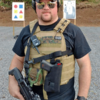I have received a few questions about how to carry a firearm and if you should carry a firearm if you have some type of physical limitations, so I thought that would be a great place to start off for this week.
We got a strong reader reaction to the previous “Fitness and Firearms” post, which made the case that people who became so unfit for whatever reason shouldn’t carry because they put themselves at risk. Many people argued that because they’re unfit, they should especially carry, so that they have a fair chance to protect themselves. This article is about looking at that issue a little more. If you are going to carry and you have a disability, be smart about it.
Having a physical limitation is very common, and does not necessarily mean that you are no longer capable of carrying a firearm to defend yourself or your family. However, there are some factors that should be considered before doing so.
There is so much more to carrying for personal defense than just putting a firearm on your belt and heading out the door. It is highly recommended that before carrying for personal defense, individuals should attain a level of proficiency. That is for the individual’s safety, as well as the safety of everyone else around them. That being said, the first thing to take into account is that whether this physical limitation is permanent or temporary. Either way, you are going to have to adjust how you train to prepare yourself to carry.
Become proficient with the non-dominant hand
If a physical limitation leaves someone only able to use their non-dominant hand, they are going to have to spend some time becoming proficient drawing the firearm from concealment with their non-dominant hand, possibly without the assistance of their dominant hand at all. That individual would also have to spend some time shooting with the non-dominant hand to make sure that they can maintain an acceptable level of accuracy, especially under stress.
Carrying a firearm for self-defense is only a good idea if the individual can hit the intended target. Shooting an innocent bystander, even by mistake, is never acceptable and the shooter could be held liable both criminally and civilly.
Dry-fire practice is going to be crucial for reaching these goals. It takes 1,000 repetitions to make a habit. If a shooter is unable to use their dominant hand due to injury or another circumstance, it is going to take 1,000 repetitions to build their skills back up using the non-dominant hand to accomplish those goals.
Practice loading and reloading
It is also imperative that the shooter spend a substantial amount of time practicing loading, re-loading, and weapons malfunction drills. Even an experienced shooter will have to spend quite a bit of time re-learning these skills with their non-dominant hand, possibly even one-handed with no assistance from the other hand. The time to try to work through a situation like that is during dry fire practice, not
in a life or death situation.
The ultimate goal when it comes to carrying a firearm is safety. This includes the safety of the individual carrying the firearm. If carrying a firearm is going to put that person in an unsafe situation, then it would be highly recommended to spend some more time re-learning these skills with any physical limitation they may have before they start carrying again.
Get new gear
One other aspect I would like to cover on this topic is gear. The gear an individual may have used on a regular basis may not still be a viable option if a physical limitation is due to the result of an injury or other circumstance that occurred suddenly or unexpectedly. It is highly recommended to go back to the drawing board with gear. It may be a better decision to buy new gear that will facilitate the portation or presentation of the firearm with a specific physical limitation.
For example, if an individual suffered an injury and no longer had the ability to use their dominant hand or arm, it would be recommended to buy gear designed for use with the non-dominant hand to facilitate usage rather than try to fight
through the situation using gear that was suited for the injured or incapacitated hand. It is always
recommended to ensure that carrying a firearm does not put the individual carrying at a higher risk of
injury or death.


